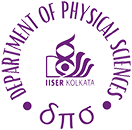
𝗘𝗺𝗲𝗿𝗴𝗲𝗻𝗰𝗲 𝗼𝗳 𝗾𝘂𝗮𝗻𝘁𝘂𝗺 𝘄𝗼𝗿𝗺𝗵𝗼𝗹𝗲 𝗴𝗲𝗼𝗺𝗲𝘁𝗿𝘆 𝗮𝗰𝗿𝗼𝘀𝘀 𝗮 𝗙𝗲𝗿𝗺𝗶 𝘀𝘂𝗿𝗳𝗮𝗰𝗲 𝗴𝗮𝗽𝗽𝗶𝗻𝗴 𝘁𝗿𝗮𝗻𝘀𝗶𝘁𝗶𝗼𝗻: 𝗨𝘀𝗶𝗻𝗴 𝘁𝗵𝗲 𝗵𝗼𝗹𝗼𝗴𝗿𝗮𝗽𝗵𝗶𝗰 𝗽𝗿𝗶𝗻𝗰𝗶𝗽𝗹𝗲 𝘁𝗼 𝘁𝗿𝗮𝗰𝗸 𝗰𝗵𝗮𝗻𝗴𝗲𝘀 𝗶𝗻 𝗺𝗮𝗻𝘆-𝗽𝗮𝗿𝘁𝗶𝗰𝗹𝗲 𝗲𝗻𝘁𝗮𝗻𝗴𝗹𝗲𝗺𝗲𝗻𝘁
Reference: Holographic entanglement renormalization for fermionic quantum matter. J. Phys. A: Math. Theor. 57, 275401 (2024), DOI: 10.1088/1751-8121/ad56e1
Authors: Abhirup Mukherjee, Siddhartha Patra and Siddhartha Lal
URL: https://t.ly/MaqVk
Juan Maldacena's version of the holographic principle posits a duality relation between a quantum field theory in d-spatial dimensions and a gravity theory in d+1-spatial dimensions. The additional dimension can be visualised as the geometrization of the scaling of various parameters, as well as the many-particle entanglement within, the (almost) critical field theory placed on a "boundary" and which extends into the bulk. This is also known as the AdS/CFT (or gauge-gravity) correspondence, and has been applied mostly as a conjecture reliant on a dictionary between two very different theories. However, employing the conjecture as a computational tool is not without its difficulties. As put forward eloquently by Andrew Green [1],
Indeed, the situation is even more delicate, since at present we cannot deduce the gravitational dual corresponding to any particular microscopic condensed matter Hamiltonian. ... Even accepting the power of this approach, there are good reasons to attempt to construct the gravitational dual to a given condensed matter system directly. Not least amongst these is the determined independence of condensed matter physicists. It rests rather uncomfortably to take anything upon the authority of mathematical tools with which one is unfamiliar. This is a tricky task. In constructing such a dual theory, we must, in a sense, solve precisely the problems that we in the condensed matter community have been struggling with.
In a work that has appeared online just recently, Abhirup Mukherjee, Siddhartha Patra, and Siddhartha Lal have provided an explicit analytic demonstration of the holographic principle by studying a simple and tractable problem: a free fermion system with and without a mass gap (where the gap is an outcome of electronic correlations). The authors employ quantum information measures (such as entanglement entropy and multipartite information) to reveal hierarchical structure within the nature of entanglement possessed by the system. Further, they relate geometric parameters like distance and curvature of the holographic dimension to a renormalization group (RG) beta function of the mass gap, providing thereby an explicit analytic manifestation of the holographic principle.
Their work suggests that the conjectured principle is likely very useful in understanding the properties (e.g., quantum phase transitions) of systems of interacting fermions. Indeed, these transitions appear in the form of wormholes in the associated extra spatial dimension (see figure). More precisely, this wormhole is characterised by a change in the boundedness of the spatial dimension (i.e., its curvature) and corresponds to a change in a topological quantum number of the ground state of the many-electron system (i.e., the Luttinger volume). The additional (conformal) symmetry at the quantum phase transition links the emergent metric and the stress-energy tensor. Finally, in the presence of a strong transverse magnetic field, the Luttinger volume in the metallic state is found to transform into the Chern number of the insulating integer quantum Hall state.
References
[1]: An introduction to gauge-gravity duality and its application in condensed matter. A.G. Green. Contemporary Physics, 54:1, 33–48 (2013).
#Research Highlight
Posted on: July 12th, 2024

